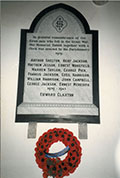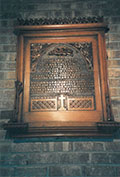Private George Pearson Jackson, 266917
- Batt - 1/7
- Unit - Nottinghamshire & Derbyshire Regiment (Sherwood Foresters)
- Section -
- Date of Birth - 1895
- Died - 21/03/1918
- Age - 22
Add to this record?
If you have photographs, documents or information that can contribute to this record, you can upload here
ContributeSource: Michael Doyle Their Name Liveth For Evermore: The Great War Roll of Honour for Leicestershire and Rutland. He was the son of James Jackson, an iron ore labourer, born 1864 in Lincolnshire and his wife Lizzie Ellen Jackson (nee Pearson, married on the 16th March 1885 in Eaton Parish Church), born 1865 in Eaton, Leicestershire, baptised on the 20th April 1865 in Eaton Parish Church. In the first quarter of 1901, George’s father died aged 37 and was interred on the 5th February 1901 in Eaton. George Pearson was born in the 3rd quarter of 1895 in Eaton, his siblings were, Thomas William, an ordinary agricultural labourer, born 1885, baptised on the 26th July 1885 in Eaton Parish Church, Fred, a domestic page, born 1887, baptised on the 8th February 1887 in Eaton Parish Church, Walter, a schoolboy, born 1888, baptised on the 23rd December 1888 in Eaton Parish Church, Bertie, a schoolboy, born in the 4th quarter of 1891, baptised on the 4th October 1891 in Eaton Parish Church, Arthur, a schoolboy, born 1897, baptised on the 23rd May 1897 in Eaton Parish Church and Arthur James, born 1901, baptised on the 7th April 1901 in Eaton Parish Church, all his siblings were born in Eaton, in March 1901 the family home was at School Lane, Eaton. In April 1911 George was absent from the family home at Eaton, residing there was his widowed mother and siblings, Bertie, an ironstone trade worker, Albert, a farm horseman, Florrie, a schoolgirl, born 1899, in Eaton, baptised on the 12th March 1899 in Eaton Parish Church and Arthur, a schoolboy. Prior to the war George had been an ironstone miner, after enlistment he had been serving with the 2/7th Battalion Nottinghamshire & Derby Regiment, but on the 6th February 1918 this Battalion was absorbed into the 1/7th Battalion Nottinghamshire & Derby Regiment, he was killed in action at the Battle of St. Quentin, and was awarded the British War and Victory medals. His older brother Bertie, fell in action in September 1916.
The War Diary records: 21 Mar-18 – NOREUIL Sector H.Q. at C.11.c.65.98. At 4.56 am the enemy put down a very heavy barrage on the front line system; trench mortars and field artillery continued the bombardment at an intense rate until about 8.45 am. At the same time, our battery positions were heavily engaged by the enemy’s heavy and field artillery. At 5.05 am communication by wire to Brigade Headquarters was broken; the only message that went through after that was one by pigeon timed about 6.00 am reporting a heavy bombardment. At about 8.00 am the shelling, which had been very largely gas, changed to high explosive. At about 10.00 am the barrage was reported to have lifted on to the second system, i.e., it was behind the Battalion. Only 14 men of the Battalion escaped unwounded from the trenches and it appears from their reports that the enemy broke through on both flanks, and, coming round behind the QUEANT – ECOUST railway cut off and completely surrounded the Battalion. This must have been between 9.30 and 10.00 am. Captain H. G. WRIGHT and Lieutenant G. W. BLOODWORTH were wounded and escaped; all the other Officers are still missing, with the exception of 2nd Lieutenant J. L. HOY and 2nd Lieutenant A. G. J. MELHUISH who were reported killed. Owing to this and to the capture of all documents at Battalion Headquarters, no accurate or detailed account of the action is possible. During the evening a few men who were not in the trenches were collected by the Brigade Headquarters and sent up to man the Reserve line of third system: The Support line of the third system was taken over by the 177th Infantry Brigade who had been relieved in the firing line of the third system by the 40th Division. Casualties, and appreciations by the Corps and Brigade Commanders are attached in the Appendix.
APPENDIX “A”.
Total strength of Battalion March 1st 1918.
Officers, 50. Other ranks, 1040.
Total fighting strength. Officers, 36. Other ranks 834.
On Command.
Brigade and Divisional Employment. Officers, 2. Other ranks, 55.
Trench Mortar Battery. Other ranks, 9.
Leave. Officers, 4. Other ranks 25.
Hospital. Other ranks, 26.
Courses. Officers, 7. Other ranks, 42.
Depot Battalion. Officers, 1. Other ranks, 34.
2 Company, Army Service Corps. Other ranks, 2.
170th Tunnelling Company, Royal Engineers. Other ranks, 13.
Total Strength March 1st 1918. Officers 50. Other ranks 1040.
Increase.
Reinforcements. Other ranks 31.
Rejoined. Officers, 1. Other ranks, 17
Totals. Officers, 51. Other ranks, 1088.
Decrease.
Missing. Officers, 23. Other ranks, 614.
Killed. Officers, 1. Other ranks 2.
Wounded. Officers, 3. Other ranks, 18.
Died of wounds. Other ranks, 2.
Evacuated. Other ranks, 76.
England. (Tour of Home duty). Officers, 2.
England. Sick. Officers, 1.
Base. Officers, 1.
Surplus Personnel. Officers, 1. Other ranks, 5.
Employment Base. Other ranks, 2.
England Command. Other ranks 2.
To Machine Gun Company. Other ranks, 4.
Totals. Officers, 32. Other ranks, 725.
Total strength of the Battalion March 31st 1918. Officers 19. Other ranks, 363.
Total fighting strength on Command. Officers 12. Other ranks, 189.
On detachment. Officers, 7. Other ranks, 174.
Totals. Officers, 19. Other ranks, 363.
Copy.
2/5th, 2/6th, 7th Sherwood Foresters, 470th Field Company Royal Engineers, 178th Infantry Brigade.
I would have liked to have been the first to tell the Brigade personally how much I appreciated their effort on the 21st and 22nd March, but now that His Majesty the King and the general Officer Commanding Division have both inspected the Brigade and talked to them, I feel I cannot possibly add anything to what they have said in the way of praising their high fighting qualities.
It might be of interest to all to know that all my telephone lines to the 3 Battalions in the line were broken during the first 10 minutes of the bombardment, and beyond talking to the Signalling Officer of the 2/6th Battalion Lieutenant HICKMAN, about 5.05 am I had no communication whatever with them except as follows.
A wireless message came in from 7th Battalion to say that their right and left front Companies reported they were being heavily bombarded at 6.30 am. A message by pigeon was sent off at 10.30 am by 2.6th Battalion to say that enemy had broken through on both their flanks but they were still holding out. Three or four messages by runner were received from 2/5th Battalion, the last one was timed 12.00 noon saying that Colonel GADD and 150 men were holding out in the Sunken Road between NOREUIL and LONGATTE and that the enemy had taken DEWSBURY and PONTEFRACT trenches and was working round his right.
There is no doubt that the Brigade delayed the enemy’s attack long enough for reinforcements to be brought up – to stop it altogether would have been impossible.
It took the enemy 4 hours to advance 2,500 yards.
There were undoubtedly 4 Divisions if not 5 against us.
I only wish to add that I am prouder than ever of the Brigade and that I deeply regret the heavy losses incurred to all those gallant officers and men who are killed, wounded or missing.
Signed. T. W. STANSFIELD. Brigadier General. Commanding 178th Infantry Brigade.
30.3.18.
1730/16.G.
30.3.18.
176th Infantry Brigade. 59th Battalion Machine Gun Company.
177th Infantry Brigade. 6/7th Royal Scots Fusiliers.
178th Infantry Brigade.
Divisional Train.
C.R.A. A.D.M.S.
C.R.E. D.A.D.V.S.
Signals. D.A.D.O.S.
The following extract from a letter addressed to the Divisional Commander by Lieutenant General Sir J. Aylmer Haldane, K.C.B., D.S.O., Commanding VI Corps is published for information.
Signed R. H. G. Gorton. Bt. Colonel. G. S. 59th Division. 3.3.18.
Will you please convey to all ranks of your Division my admiration and thanks for the very gallant stand they made against overwhelming numbers of the enemy supported by a tremendous artillery.
The Division nobly did their duty on the right of VI Corps, and from all accounts that have reached me have inflicted heavy loss upon the enemy. I grieve for the heavy casualties among your gallant officers N.C.Os and men, they did their duty in as trying circumstances as can possibly happen in war.
On Friday May 10th 1918 The Melton Mowbray Times & Vale of Belvoir Gazette published the following article under the heading. “EATON.” – LOCAL SOLDIER MISSING. – News has been received by Mrs. Elizabeth Jackson (widow), that her son, Pte. George Jackson, Sherwood Foresters, has been posted as missing, since March 21st. He joined the army about two years ago and spent nine months in Ireland. He had been in France about 15 months. The news is a severe blow to Mrs. Jackson, who had a son Bertie, killed in action, in September 1916.
- Conflict - World War I
- Unit - Nottinghamshire & Derbyshire Regiment (Sherwood Foresters)
- Former Unit n.o - 266917
- Former Unit - 2/7th Bn. Nottinghamshire & Derby Regiment (Sherwood Foresters)
- Cause of death - KILLED IN ACTION
- Burial Commemoration - Arras Mem., France
- Born - Eaton, Leicestershire
- Enlisted - Nottingham
- Place of Residence - Ivy Cottage, Eaton, Leicestershire, England
- Memorial - ST. DENY'S CHURCH, EATON, LEICS
- Memorial - EATON SCHOOL MEM., LEICS
- Memorial - VILLAGE HALL MEMORIAL, EATON, LEICESTERSHIRE


